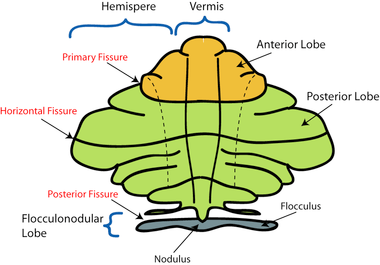Truncal ataxia
Truncal ataxia (or trunk ataxia) is a wide-based "drunken sailor" gait characterised by uncertain starts and stops, lateral deviations and unequal steps. It is an instability of the trunk and often seen during sitting.[2] It is most visible when shifting position or walking heel-to-toe.[1]
| Truncal ataxia | |
|---|---|
| Other names | Trunk ataxia, Ataxic gait[1] |
 | |
| Caused by midline damage to the cerebellar vermis | |
| Specialty | Neurology |
| Symptoms | "drunken sailor" gait characterised by uncertain starts and stops, falling |
| Causes | Spinocerebellar Ataxia |
As a result of this gait impairment, falling is a concern in patients with ataxia.[3]
Truncal ataxia affects the muscles closer to the body such as the trunk, shoulder girdle and hip girdle. It is involved in gait stability.[3]
Truncal ataxia is different from appendicular ataxia. Appendicular ataxia affects the movements of the arms and legs. It is caused by lesions of the cerebellar hemispheres.[3]
Causes
Truncal ataxia is caused by midline damage to the cerebellar vermis. There are at least 34 conditions that cause truncal ataxia.[2]
Common
Uncommon
- Adrenoleukodystrophy[4]
- Ataxia oculomotor apraxia type 1[4]
- Branchial myoclonus[4]
- Christianson syndrome[4]
- Dandy-Walker syndrome[4]
- Dysequilibrium syndrome[4]
- Epilepsy[4]
- Episodic ataxia[4]
- Post viral cerebellar ataxia[1]
- Gerstmann-Straussler-Scheinker syndrome[4]
- Machado–Joseph disease[4]
- Microcephaly[4]
- N-acetylaspartate deficiency[4]
- Neuhauser Eichner Opitz syndrome[4]
- Paraneoplastic cerebellar degeneration[1]
- Polymicrogyria[4]
- Rett syndrome[4]
- Spinocerebellar ataxia[4]
- Vertebral dissection[1]
References
- Dennis, Mark; Bowen, William Talbot; Cho, Lucy (2012-01-27). Mechanisms of Clinical Signs - E-Book. pp. 280–281. ISBN 9780729580755.
- "NCBI Truncal ataxia". NCBI. Retrieved March 17, 2019.
- Blumenfeld H (2002). Neuroanatomy through clinical cases. Sunderland, Mass: Sinauer. pp. 670–671. ISBN 0-87893-060-4.
- "human phenotype ontology". Retrieved March 17, 2019.